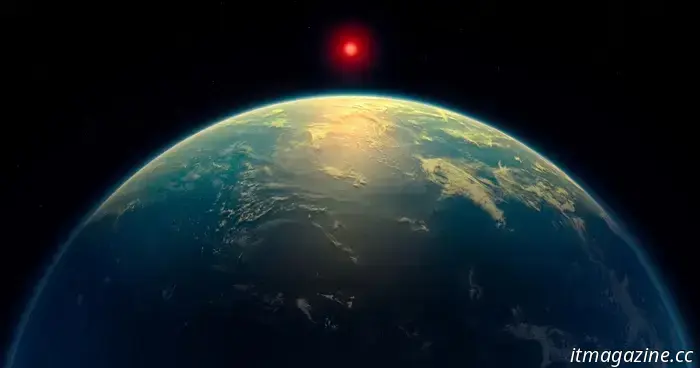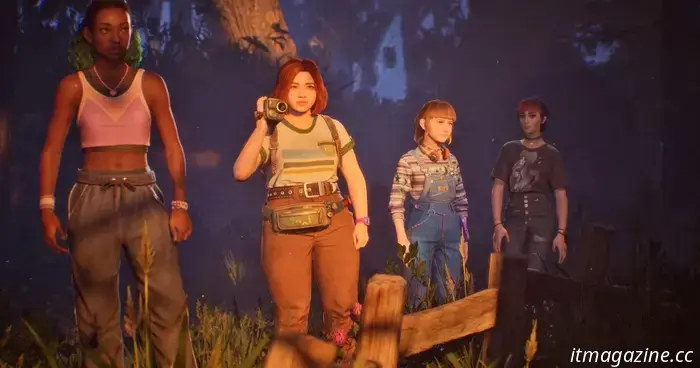
Could this exoplanet be 'full of life'? Clues of life beyond our solar system.
Illustration of a Hycean world.
A. Smith, N. Madhusudhan (University of Cambridge)
In a remarkable new discovery, astronomers have found what they assert is the strongest evidence to date of life beyond our solar system. Utilizing the James Webb Space Telescope, researchers from the University of Cambridge, UK, have identified a compound on the planet K2-18b that is produced by microbial life.
The study indicates that K2-18b is likely a Hycean planet, situated within its star's habitable zone and covered by a liquid water ocean. This type of planet is considered an ideal candidate for the search for life due to its abundant water and hydrogen-rich atmosphere.
When researchers examined the planet using Webb’s Mid-Infrared Instrument (MIRI), they discovered the chemical signature of dimethyl sulfide (DMS) and/or dimethyl disulfide (DMDS). On Earth, these compounds are exclusively produced by life forms like marine phytoplankton, and while they exist in minuscule amounts here, they are present on K2-18b in quantities thousands of times greater.
“Previous theoretical studies suggested that high levels of sulfur-based gases like DMS and DMDS could be found on Hycean worlds,” stated lead researcher Nikku Madhusudhan. “Now we've observed it, confirming earlier predictions. Based on what we know about this planet, a Hycean world with an ocean rich in life fits the data best.”
Despite this, the researchers caution that this does not constitute definitive proof of life, as the compound could potentially be generated by an unknown chemical process. Additionally, prior studies on K2-18b did not find evidence of DMS or DMDS, and detecting compounds in the atmosphere of such a faraway planet presents challenges, making the findings contentious.
“It’s crucial to maintain a healthy skepticism about our findings, as it’s through rigorous testing that we can gain confidence in them,” Madhusudhan remarked. “That’s the essence of scientific inquiry.”
The team aims to conduct further studies to determine whether DMS and DMDS could arise from chemical reactions instead of biological processes, particularly given the large quantities identified on the planet. They view their results as a "starting point" for additional exploration in the quest for extraterrestrial life.
“Years from now, we may reflect on this moment as when the living universe became more accessible,” Madhusudhan suggested. “This could mark a pivotal moment where the fundamental question of our solitude in the universe becomes one we can begin to answer.”
The research has been published in The Astrophysical Journal Letters.
Georgina has been writing about space for Digital Trends for six years, covering topics related to human space exploration and planetary science.
UAE to send its first mission to the solar system’s main asteroid belt
Following the success of its Mars mission, the United Arab Emirates (UAE) intends to launch a new spacecraft to an asteroid belt to explore the solar system's history and the potential origins of life. The Emirates Mission to the Asteroid Belt (EMA) aims to reach its first asteroid by 2030. It will investigate multiple asteroids in the belt between Mars and Jupiter, following a launch in 2028, with plans for a landing as well. The spacecraft will be named MBR in honor of the ruler of the UAE.
Read more
Tidally locked exoplanets could be habitable in the ‘terminator zone’
Exoplanets can exhibit a variety of unusual environments, and one relatively common characteristic among them, which is absent in our solar system, is tidal locking. This occurs when one hemisphere of the planet is always oriented toward its star, while the opposite side faces deep space, resulting in extreme temperature differences—one side becoming extremely hot and the other freezing cold. While this may not seem conducive to life, recent research indicates the possibility of habitability in a narrow region separating these two extremes. Known as the "terminator zone," this area encircles a planet between the scorching dayside and the frigid nightside, delineating two sharply contrasting climates. “On these planets, the dayside might be unbearably hot, far exceeding conditions suitable for life, while the night side could be icy and potentially glaciated,” explained lead researcher Ana Lobo from the University of California, Irvine.
Read more
Water was present in our solar system before the Sun formed
It is a common assumption that water has always existed on Earth from the moment of its formation. However, scientists are increasingly inclined to believe that our planet's water might have originated from elsewhere, arriving via comets. Nevertheless, the water in these comets must have originated from somewhere, and astronomers have recently made a discovery that may illuminate how that water came to be in the solar system. Researchers utilized the Atacama Large Millimeter/submillimeter Array (ALMA), a radio telescope array located in Chile, to investigate a





Other articles
 Lost Records: Bloom and Rage review: punk rock endures.
Lost Records: Bloom and Rage reimagines the Life is Strange formula, crafting a profoundly emotional coming-of-age narrative set in the 90s.
Lost Records: Bloom and Rage review: punk rock endures.
Lost Records: Bloom and Rage reimagines the Life is Strange formula, crafting a profoundly emotional coming-of-age narrative set in the 90s.
 UK deploys microwave weapon capable of disabling drones as part of a defense technology initiative.
The British Army has neutralized swarms of drones using the “RapidDestroyer,” a new defense technology that employs high-frequency microwaves.
UK deploys microwave weapon capable of disabling drones as part of a defense technology initiative.
The British Army has neutralized swarms of drones using the “RapidDestroyer,” a new defense technology that employs high-frequency microwaves.
 The most intriguing feature of Gemini is now available for free to all Android users.
Google has announced that the impressive Gemini screen sharing and camera functionality will be accessible to all Android users.
The most intriguing feature of Gemini is now available for free to all Android users.
Google has announced that the impressive Gemini screen sharing and camera functionality will be accessible to all Android users.
 NYT Crossword: solutions for Thursday, April 17
The crossword puzzle in The New York Times can be challenging, even if it's not the Sunday edition! If you're facing difficulties, we're available to assist you with today’s clues and solutions.
NYT Crossword: solutions for Thursday, April 17
The crossword puzzle in The New York Times can be challenging, even if it's not the Sunday edition! If you're facing difficulties, we're available to assist you with today’s clues and solutions.
 Startup competition aims to find sustainable solutions for AI's energy requirements.
The Energy Innovation for AI Startup Challenge will wrap up with a live pitch competition at the TNW Conference on June 19.
Startup competition aims to find sustainable solutions for AI's energy requirements.
The Energy Innovation for AI Startup Challenge will wrap up with a live pitch competition at the TNW Conference on June 19.
 The Galaxy S25 does not appear to be the success that Samsung had hoped for.
Data indicates that Samsung is just slightly ahead of Apple in terms of market share, as their strategies may not have performed as anticipated.
The Galaxy S25 does not appear to be the success that Samsung had hoped for.
Data indicates that Samsung is just slightly ahead of Apple in terms of market share, as their strategies may not have performed as anticipated.
Could this exoplanet be 'full of life'? Clues of life beyond our solar system.
A fascinating discovery suggests the potential for life beyond our solar system.
